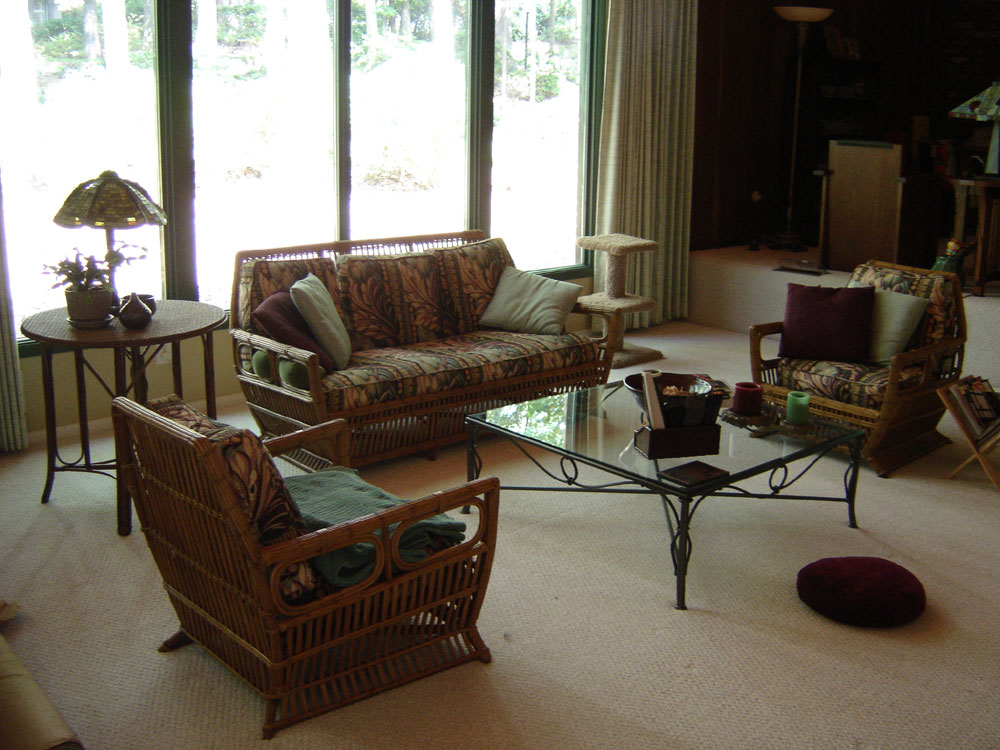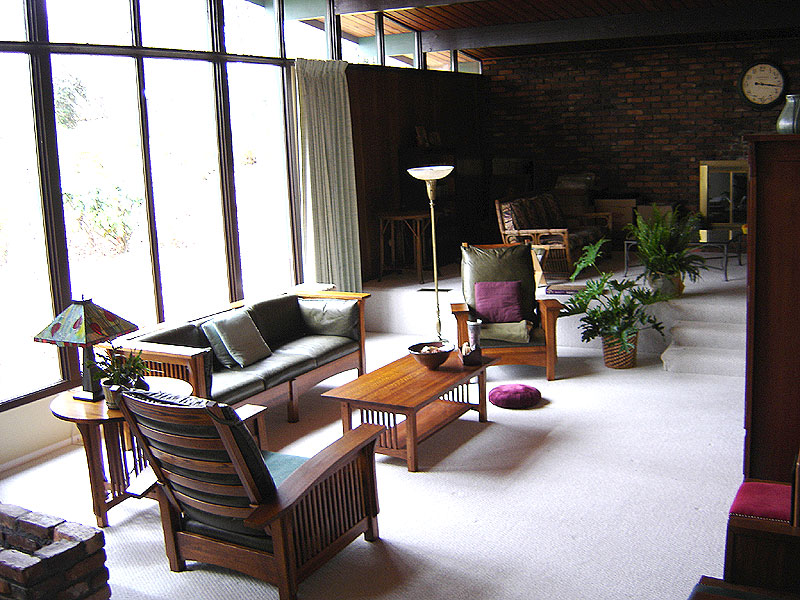
 |
| Reed Couch and Chairs |
The sofa and two chairs above were given to Cindis mom after living in the den near the fireplace.
 |
| Quarter-sawn oak Craftsman Furniture from Restoration Hardware |
We were able to obtain a nice set of Arts and Crafts (AKA Craftsman) furniture, similar to the designs of Stickley, that was better suited to the size of the room. At that time we hadnt yet gotten the bug to go all Mid-Century Modern, so the furnishings more than sufficed for day-to-day living. You can see the reed sofa in the background.
So recently I started obtaining some projects to replace the Craftsman furniture - so far, three Jens Risom Lounge chairs, two Jens Risom side chairs, a nice square Knoll table and most recently, a Jens Risom sofa. That last was the final piece we needed to basically replace what we had with a similar configuration. Heres an image of the Platner coffee table:

So I bet youre asking why Im going through all this? The Platner table came down from New York with Cindis mom - and it looked really odd with the reed furniture - the high-tech chrome wires didnt work with the reeds in the couch and chairs. Since we were going all modern, we were offered the table - the only problem - she needed something that could replace it. After looking for a bit, we figured out that what she needed was something more in the same scale and a bit retro - ideally of wood or something with the same brown tones. We found a structurally sound Lane Acclaim table - a bit beat up, with water and mineralization rings on top and a hammered finish (it was also quite dirty), but we paid little enough for it that it was worth getting as a potential replacement after a bit of TLC.
The things that sold me on the table: 1. It was all solid wood construction - even the flat table top was wood planks edge-jointed with the interesting walnut and oak veneers on top. 2. No racking or twisting to the legs - the end mortises into the legs and underlying supports made for a well-made, strong table. 3. Nothing in the finish looked like too large a task to re-do. 4. The veneers were all laying flat so I didnt have to worry about loosening the veneer and getting it to re-adhere (this last one fooled me a bit as Ill explain). 5. I grew up with Lane Acclaim (we had a rectangular coffee table and two end-tables) so I just like the design.
Unfortunately I wasnt very diligent in taking photos, so I dont have any of the table before I started. I literally thought this was going to be a "quick-and-dirty" refinish job so I got it into the shop and first gave it a good cleaning. I discovered that the lacquer finish had just about had it so first I tried lacquer thinner to strip it off, and eventually just carefully sanded it (there were dark spots embedded into the veneers that wouldnt clean up - fortunately almost all of it was removed with light sanding). This is the result:

A couple of things to note: 1. look at the near edge - see the spalting? That was all stained dark enough so you didnt see it before I stripped off the original finish. 2. Even being extremely careful, I managed to sand through the veneer in one corner (its the one to the right - unfortunately out of frame) to the poplar beneath. I figured that once I stained and coated the top it wouldnt be noticeable, and for once I was right. You dont see it unless its pointed out to you.
I did a few searches online to figure out what stain to apply - theres a Min-Wax that I found suggested on one bloggers post (pdx picker) with some photos and it seemed reasonable - the stain used was Minwax Early American. Remember, I wasnt looking for perfection here, just something I could quickly work out and deliver (note the date in the photo above is 19? Thats 2012.08.19. I did want to do a reasonable restoration with colors approximating the original, along with a lacquer finish (what was originally applied).
I figured I could apply a stain and go directly into a lacquer and be done. Theres only one problem - I dont like Min-Wax. Oh, sure its a good product, but the problem I have with it is that it already has a varnish added to it - which makes it impossible to adjust if your tint isnt quite right. I know that there are alternative ways to adjust, but doing airbrushed coats layered between sealers didnt fit into my "quick-and-dirty" idea. I did manage to find a finish that approximated what I was looking for - Varathane American Walnut found at the Home Depot. Now in retrospect, theres a bit more red and less yellow in this stain so its not quite right, but close enough for me.
Heres the table with stain applied:

One thing I noticed in some of the other Lane Acclaim refinsh photos available online - for some reason people are selecting finishes that dont bring the color of the oak down into the browns - the contrast to me is quite disturbing. In my case, except for the bit of red tint this is very close to the color of the legs.

I next appled a couple of wash coats of shellac to seal things up. This also brought a little yellow back into the mix and neutralized the red a bit:

After a bit of block-sanding to get everything flat, I applied the lacquer. Now this is where I totally hosed everything. I had always applied lacquer in the past using a sprayer, or in a pinch, a rattle can - but in my rush to get this thing done I decided to apply it via brush. The problem here is that I dont own a good varnish brush - you want something that holds the varnish and lays down a very even coat with minimal brush marks - any ridging that happens will need to be sanded down. After two coats I had something that looked obscene and it took quite a bit of sanding to get it looking right. Of course there were some imperfections but I thought, OK Ill just apply some wax. Another mistake - the wax made every imperfection glow-in-the-dark and applied a glossy sheen that wasnt appropriate to the piece. I was going to strip off the wax but ran out of time. In desperation I just hit the whole thing with some 000 steel wool and got the finish back to something close to what I was looking for. As a last step I cleaned up the legs and applied a light coat of wax with very light buffing - that brought up the old finish to the same luster as the new.
Here are some photos of the finished table before being loaded into the back of the Highlander, right after hitting it with steel wool (that was Thursday night 2012.10.04):




Im not quite sure how it ended up being a 6 week project - I really thought I could get it done in a weekend. Lessons learned here: 1. Im too much of a perfectionist to do any "quick and dirty" projects when it comes to refinishing. 2. Invest in the time to get the stain right and dont settle for "close" 3. Always, always apply lacquer using the sprayer - for the time it took me to block everything out I could have purchased a whole case of rattle can lacquer. 4. Know youre still taking a risk in the veneer even if the pieces are flat (I actually think that the corner where I sanded through - you can see it in the last photo, the left corner closest to you - was thin to begin with, probably from the Lane factory.
Thats my story. Hope you enjoyed it and learn from my mistakes. John




0 komentar:
Posting Komentar
Catatan: Hanya anggota dari blog ini yang dapat mengirim komentar.